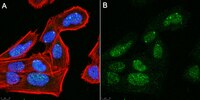MABE1894-25UL Sigma-AldrichAnti-Orc1 Antibody, clone 78-1-172
Anti-Orc1, clone 78-1-172, Cat. No. MABE1894, is a mouse monoclonal antibody that detects Orc1 and is tested for use in Chromatin Immunoprecipitation (ChIP), Immunocytochemistry, Immunohistochemistry
More>> Anti-Orc1, clone 78-1-172, Cat. No. MABE1894, is a mouse monoclonal antibody that detects Orc1 and is tested for use in Chromatin Immunoprecipitation (ChIP), Immunocytochemistry, Immunohistochemistry (Paraffin), and Immunoprecipitation. Less<<Recommended Products
-

MABE348 Sigma-Aldrich Anti-phospho-RNAPII Antibody (Thr4), clone 1G7 -

NU100/39-211 Millipore NovAseptic Valve, Valve Body, Divert Valve -

1098860001 Supelco Buffer concentrate -

ANS5/127X94-311 Millipore NovAseptic Connector, In-Line, Butt End According to Tube Standard ASTM A269/270 -

SK1M017W01 Millipore Pellicon® 2 Maxi Cassette with Biomax® 8 kDa Membrane, C screen, 2.5 m² -

442611 Millipore Magnesium Chloride, Hexahydrate, Molecular Biology Grade - CAS 7791-18-6 - Calbiochem -

1072900050 Supelco Phosphate modifier -

M00000001 Millipore Sterile Sampling Tube 5in. w/Luer Fitting -

MSHAWGE48 Millipore MicropreSure Monitor, sterile, individually packed, 0.45µm white gridded -

1069060100 Millipore L-Ornithine monohydrochloride
Overview
| Product Information | |
|---|---|
| Format | Purified |
| Presentation | Purified mouse monoclonal antibody IgG1 in buffer containing 0.1 M Tris-Glycine (pH 7.4), 150 mM NaCl with 0.05% sodium azide. |
| Quality Level | MQ200 |
| Storage and Shipping Information | |
|---|---|
| Storage Conditions | Stable for 1 year at +2°C to +8°C from date of receipt. |
| Packaging Information | |
|---|---|
| Material Size | 25 µL |
| Global Trade Item Number | |
|---|---|
| Catalog Number | GTIN |
| MABE1894-25UL | 04065265324335 |










